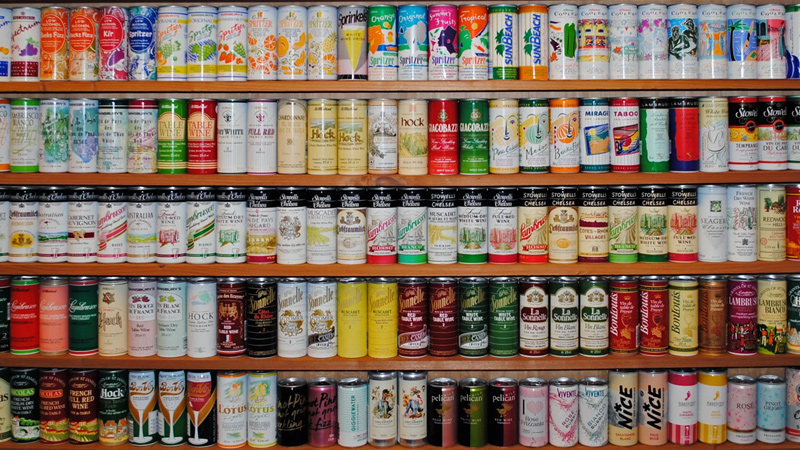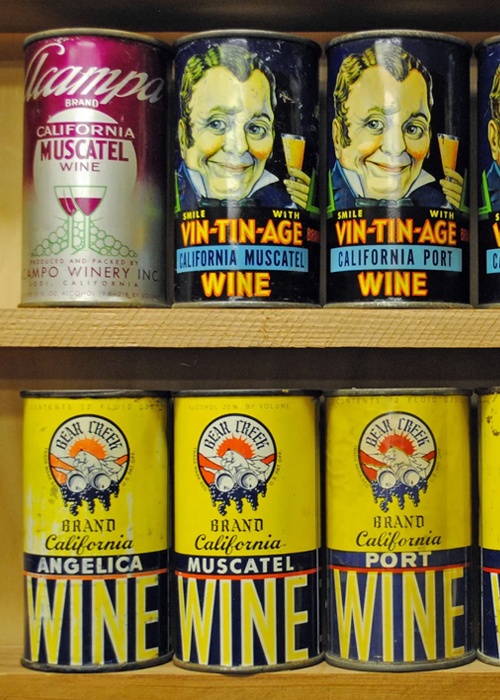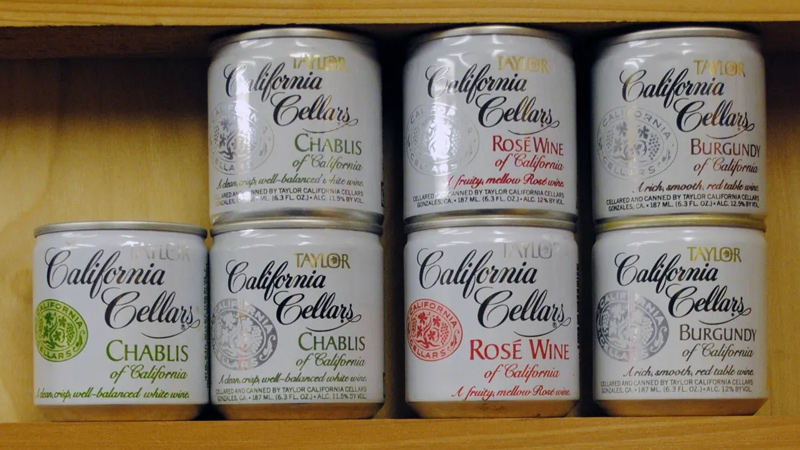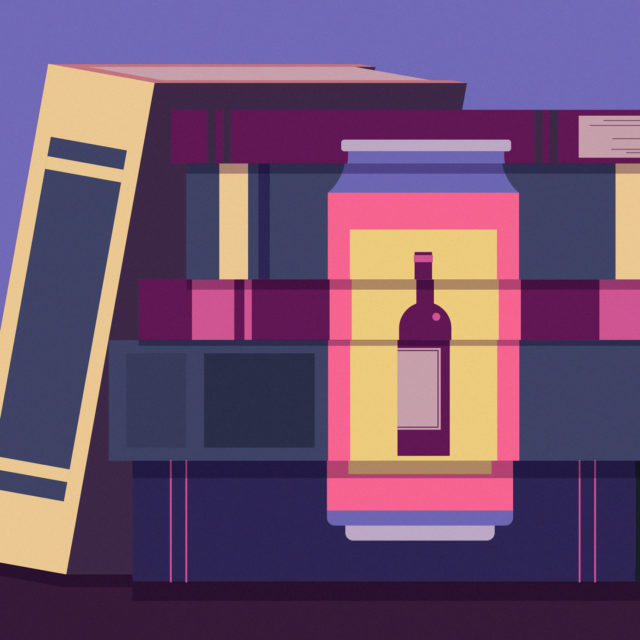Allan Green etched his name into the annals of history when he became a Guinness World Record holder on July 5, 2015. His feat: amassing the world’s largest collection of wine cans — 449 to be exact.
Green started collecting wine cans in the early ’80s at around the time he founded the Philo, Calif., winery Greenwood Ridge Vineyards, in the Anderson Valley. In the five years since he made history, Green estimates his collection has grown by more than 1,200 cans.
“I have the world’s first and second-largest collection,” he says. “I have a thousand duplicate cans that I would love to find a home for, but I haven’t been able to find anybody other than me who is a wine can collector, specifically.”
The most intriguing aspect of Green’s collection is not its sheer size, but the alternative narrative it offers on the history of canned wine. Conventional writing cites the release of Francis Ford Coppola’s Sofia Mini in 2004 as the dawn of the category — at least in the United States. A handful of other brands (Infinite Monkey Theorem, Alloy Wine Works, and Union Wine Co.’s Underwood) also enjoy a share of the limelight for being early adopters of the packaging and laying the foundation for its current success.
Yet Green’s collection tells a different story. He has wine cans that date back to 1936, the year after the Gottfried Krueger Brewing Company debuted America’s first canned beer. His collection also shows canned wine producers were innovating with closures decades before screw caps disrupted the bottle market. And as for single-serve 187-milliliter and 250-milliliter vessels? Those “modern” innovations stretch back to the 1980s and 1960s, respectively.
It’s not like these early examples were niche releases, either. Some of America’s largest wine producers were deep in the canned wine business by the 1980s. And for a brief moment, it looked like they had the market cornered, with national distribution and placement on airlines secured. But it wasn’t meant to be.
These are the canned wines time has all but forgotten.

The Early Days of Canned Wine
As soon as America emerged from Prohibition and its wine industry got back on its feet, producers started innovating. But in this case, it was an example of an industry running before it could walk.
The earliest examples from Green’s collection, which can be viewed on the web page of the International Canned Wine Competition, offer insight into the popular styles of the time. Fortified, sweet wines filled decorative steel cans, with names like Vin-Tin-Age and Sweet Adeline. The experimentation would ultimately prove short-lived.
“In addition to those wines being pretty funky to start with, the technology of coating the [inside of] cans was brand new,” Green says. “Let’s just say there was a learning curve there.”
The inner coating was essential to provide a barrier between the wine and reactive steel packaging. The only problem was, the acidity and alcohol content of the wines ate away at the protective layer, bringing the liquid into contact with the metal. Combined with the already poor quality of the wines, Green says, the packaging was “doomed from the start.”
Even with the invention of less corrosive, rust-free aluminum cans in 1959, things didn’t get much better. Six-packs of California ports and sherries made way for early experimentations with wine coolers, from brands like Redi-Shot from Denver.
Mogen David, a Chicago winery founded in 1933, put out Cold Bear Grape Wine, an 8-ounce blend of red and white packaged with a pull tab opening. Once again, the trials proved unpopular and short-lived. Yet their failures did little to dampen the spirits of wine producers.

Canned Wines Take Flight
The first golden era of American canned wine arrived at the end of the 1970s. Kernan, Calif.’s Villa Bianchi Winery (now known as Bianchi Winery and located in Paso Robles) found success with 12-ounce Lite Red and Lite White wine coolers in 1979. Three years later, the winery launched a line of California Chablis, Burgundy, and rosé wines in 6.3-ounce (187-milliliter) cans, which went on to gain distribution in 45 states.
California’s Geyser Peak Winery also released similar-sized cans of Burgundy and Chablis wines through its Summit brand. While American producers freely used the names of French regions on their cans, respect for the old guard and its stuffy traditions was fast waning.
“We want to put some fun into wine. It’s been too much aimed at the [elite],” Wayne R. Downey, Geyser Peak’s president, told The Washington Post in 1981. “We’re trying to get to the mass public, ignoring snob appeal and all that.”
It’s no surprise Downey was happy to go against the establishment. He came up not in some fancy wine importing business but in the soft-drinks industry, at the Canada Dry Corporation. It was an industry he had already revolutionized, pioneering the use of plastic bottles for soda and plastic 6-pack rings. Now he hoped to do the same to wine with $2.99 6-packs.
Downey wasn’t the only soft-drinks executive looking to fizz up the wine market. In 1977, Coca-Cola bought New York’s Taylor Wine Company, the nation’s sixth-largest producer. Coke targeted Taylor specifically because of its “stellar national distribution system,” explains wine writer Thomas Pellechia, author of “Over a Barrel: The Rise and Fall of New York’s Taylor Wine Company.”
Coke also aimed to cash in on Taylor’s favorable reputation, and soon launched a West Coast sister brand, Taylor California Cellars. “Within three years, Taylor California Cellars had gone from zero cases to about 8 million nationally,” says Pellechia.
Much like Geyser Peak and Bianchi, Coke debuted Burgundy, Chablis, and rosé wines in 6.3-ounce cans through its Taylor brands. Rather than target traditional distribution channels, Coke set its sights on the airline industry, touting the packaging as a space, weight, and ultimately fuel-saving solution.
The airlines were sold, but their customers weren’t convinced. “Fully 40 percent of our wine-drinking passengers didn’t like cans, or hated them,” Richard Arnold, United Airlines’ vice president of food service operations, told The New York Times in 1981, following a six-week trial of Taylor’s cans.

Turbulence and Tinny Tasting Notes
It was the same old problem for canned wines. Reynolds Metals Co., the canning company used by both Taylor and Geyser, claimed it had solved the inner coating problem. Yet customers still complained of tainted flavors and metallic notes.
Robert Minto, a Montana-based wine blogger and airline enthusiast, recalls trying Taylor’s in-flight canned wines just after Western Airlines merged with Delta in the mid-’80s. Minto, a frequent flier with Western, wanted to take the last flight out of Salt Lake City to New York with the airline. He would then return the next day — on the same plane and in the very same seat — as a Delta passenger. The two flights couldn’t have been more different.
“Western served Champagne in coach and they always had three red selections and two white selections in first class,” he says. “I drank some really nice French red going out from Salt Lake to New York.”
On the return flight, he inquired about the red wine options. “All we have is Taylor’s,” a Delta flight attendant told him. It was a far cry from the selection he was accustomed to choosing from at 40,000 feet. Still, Minto agreed to try it.
“She plunked down this little 8-ounce can of Taylor’s on the cart,” he recalls. “It was the most god-awful thing I’d ever tasted in my entire life.”
Within two decades, packaging companies would develop processes and upgraded cans for overcoming the taint problems once and for all. Sadly, none of the early pioneers were around to take advantage of it.
Though Bianchi and Geyser exist to this day, long gone are their days of canning wine. As for Taylor, Coca-Cola offloaded both the New York and California brands, as well as a few other wine companies it owned, to Seagrams for $200 million in 1983 (two years before Minto tried them on Delta).
For some, it’s impossible to look back at the period without thinking “what might have been,” especially given the current success of canned wines.
“It was a perfect match,” Pellechia says of the Coke and Taylor combination, citing their dual dominance of distribution. Ultimately, Coca-Cola wasn’t ready for the low margins, varying consumer trends, and inconsistent vintages that come hand in hand with wine.
Had Coke been able to live with the wine industry’s shortfalls, he says, “Taylor California Cellars could have been a striking success story today.”
Instead, it is just another name in a thousand-strong wine can collection in Philo, Calif.
This story is a part of VP Pro, our free platform and newsletter for drinks industry professionals, covering wine, beer, liquor, and beyond. Sign up for VP Pro now!
